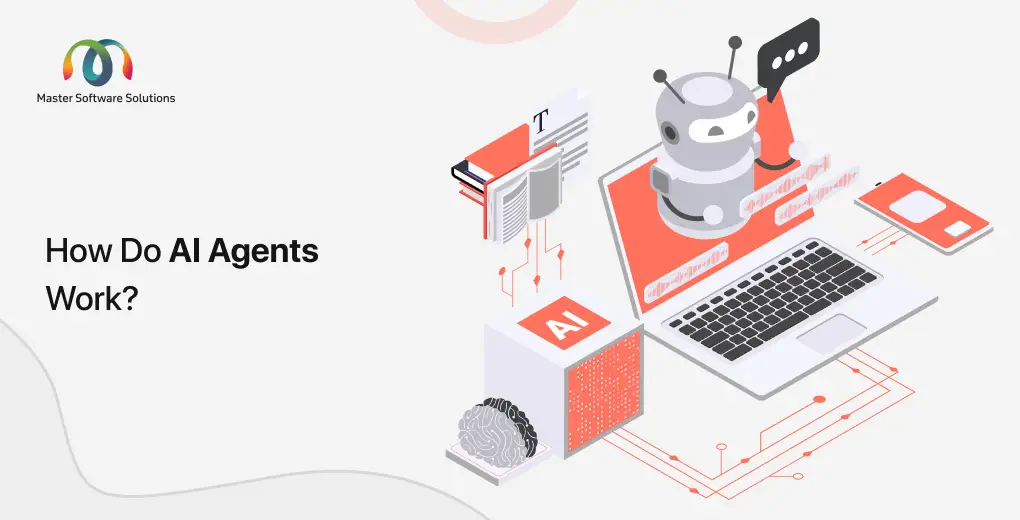How Do AI Agents Work?
AI agents, also known as autonomous systems, are independent systems that use artificial intelligence and machine learning. The system uses large language models (LLMs) and natural language processing to perform tasks, make decisions, and learn from its environment. They can perform tasks towards a predetermined goal over a timeframe, with limited or no human interference. AI agents can break down complex tasks into multiple smaller tasks and execute them to achieve the goal.
This blog will explore how AI agents work and can help you optimize business operations.
What is an AI agent?
An AI agent is an entity, software, or robot that can act independently in an environment. It gathers data from its surroundings, makes informed decisions, and performs necessary tasks. The real-world AI agent examples are warehouse robots, automated drones, self-driving cars, virtual assistants, fraud detection systems, personalized recommendations, and customer service chatbots. AI agent development can help you build custom AI agents that align with your business workflow and goals.
What is the function calling in an AI agent?
Functional calling allows AI agents to interact with external tools and APIs to identify and execute functional user input. It is a bridge between natural language and programmatic actions. It focuses on interacting with the external environment and enables AI agents to perform actions, retrieve data, and interact with other systems dynamically.
Working or function calling in AI agents:
- Detect – The AI agent detects a user query or task that requires actions that it cannot perform.
- Function selection – The agents can identify the function or API to fulfill the request.
- Parameter passing – The AI agent sends the necessary parameters to the selected function.
- Execution – The external tool or API processes the request and gives the results.
- Response integrations – The agent stores returned data into its response.
Working of an AI agent
AI agents use technologies such as large language models (LLMs), real-time data analysis, and natural language processing (NLP). These technologies empower AI agents to reason, make decisions, and complete tasks. Here are the key steps in AI agent functionality:
Perception
The AI agent gathers information or data from the surrounding environment through sensors or input data. For robots or self–driving cars, it includes cameras, lidar, radar, and other sensors. Software agents receive data from user inputs, APIs, databases, and online sources.
Processing and analysis
The agent leverages artificial intelligence (AI) to collect data and machine learning (ML) to identify patterns, make predictions, and learn from experience. It uses natural language processing (NLP) to understand and interpret human language. AI agents also use computer vision to analyze and interpret images and videos.
Decision-making
AI agents decide the line of action based on data processing and analysis. This might include:
- Rule-based system – They follow predefined “if-then” rules.
- Planning algorithms – Creating a sequence of actions to achieve a goal.
- Reinforcement learning – Learn through trial and error.
Action Execution
The AI agent performs the task, which includes moving a physical action (robot and controlling a vehicle), software actions (sending messages, updating a database), and communication (providing a user response).
Learning and adaptation
Many AI agents can train themselves from previous experience to improve their performance. They store data from past actions and outcomes. The AI agents use artificial intelligence and machine learning to identify patterns and produce effective responses. These agents are capable of making adjustments based on new information.
How an AI agent works with an example
Goal – Maintain a comfortable and energy-efficient temperature within the home.
Perception – The agent receives data from various sensors, such as temperature sensors, humidity sensors, external weather data, and user preferences.
Processing and analysis – The AI-powered agents assess the current temperature and humidity levels and check for occupied rooms to predict temperatures based on weather forecasts.
Decision-making – The AI agents decide on appropriate actions based on various factors, such as:
- If the room is occupied and the temperature is set, it activates the air conditioning.
- If the room is unoccupied, adjust the temperature to save energy.
- If the external weather is sunny, it is a good idea to reduce the heat again.
- AI agents can learn human patterns to anticipate when someone will be at home and precondition the home.
Task execution – The AI agent sends the command to adjust the thermostat settings, control the air conditioning or heating system, and open and close blinds.
Learning and adaptation – The AI agents continuously learn from user feedback, energy consumption data, and the effectiveness of their actions. After this, the agent refines its algorithms to improve efficiency and user comfort.
Conclusion
AI agents or agentics are one of the rapidly growing technologies that can provide a personal assistant to your employees. They have become a powerful tool, automating and reducing repetitive tasks to improve resilience and increase efficiency.
Master Software Solutions has 13+ years of experience and has already developed more than 100 AI agents across supply chain, retail, logistics, and warehousing. We have developed over 100 turnkey AI agent solutions that can help you simplify your business operations. Book a meeting to discuss your business and how we can help you.
